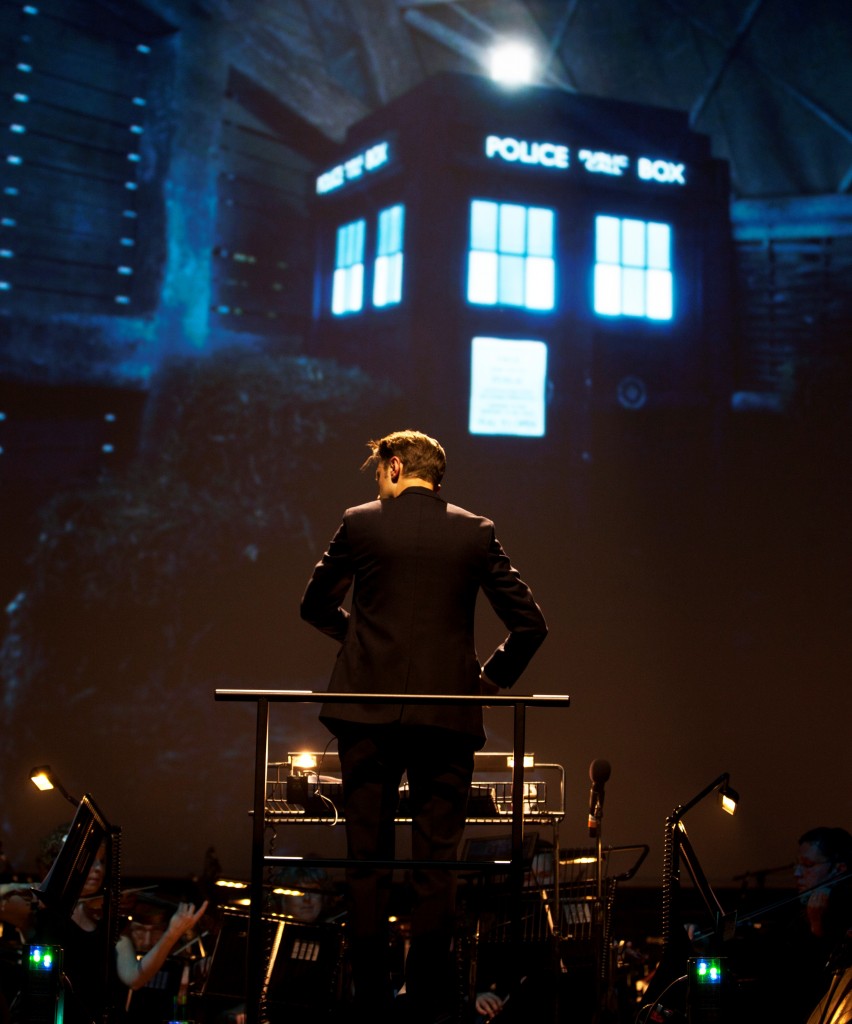 Inspired by the stunning decade of live Doctor Who recitals – including the 50th Anniversary BBC Proms in 2013 – the Doctor Who Symphonic Spectacular arrives in the UK for the very first time, celebrating the music of the world’s longest-running television series. A regular event for families in Australia, Doctor Who Symphonic Spectacular makes its début here, now touring across Doctor Who’s homeland, doing so in style and (here in London, at least) to a packed celebrity audience, including the Twelfth Doctor himself – Peter Capaldi.
Inspired by the stunning decade of live Doctor Who recitals – including the 50th Anniversary BBC Proms in 2013 – the Doctor Who Symphonic Spectacular arrives in the UK for the very first time, celebrating the music of the world’s longest-running television series. A regular event for families in Australia, Doctor Who Symphonic Spectacular makes its début here, now touring across Doctor Who’s homeland, doing so in style and (here in London, at least) to a packed celebrity audience, including the Twelfth Doctor himself – Peter Capaldi.
Vision Nine, working in association with BBC Worldwide have set about to present the very best musical experience that Doctor Who can offer, celebrating the series’ rich musical past. Focusing on the acclaimed work of Murray Gold – who has scored every episode of the series since its revival in 2005 – and with the BBC National Orchestra of Wales and the BBC National Chorus of Wales, lead by Ben Foster, the Doctor Who Symphonic Spectacular delivers on every level with assured confidence and a dazzling sparkle, all at the sweep of a Sonic Baton.
There is a clear and concise technical execution of the show in terms of staging, lighting and sound – written and directed by Paul Bullock – which adds to the slickness of Ben Foster’s elegant rapport with the BBC National Orchestra of Wales and the BBC National Chorus of Wales – a rapport no doubt built up due to Foster long history of working with both groups, orchestrating and conducting Murray Gold’s music since David Tennant’s début episode back in 2005. Not one note, not one beat, not one cue is missed to make this look like an effortlessly smooth event – no easy feat when you find yourself coming under siege from the most terrible things the universe has ever bred.
Because, yes, beware! There are monsters! A Doctor Who concert would not be complete with a large, seemingly numerous collection Doctor’s most dangerous foes sweeping us up into events, threatening to disintegrate, assimilate or exterminate. Even though the fear factor for the audience was high, there were plenty of children in the families to comfort their terrified parents, no doubt assured by the presence of the Doctor himself. Or should that be Doctors? Because Peter Capaldi was not the only Timelord present – events were wittily and charming lead by the ever-charming Peter Davison (who played the Fifth Doctor) who bantered with the performers with great ease, forming a lovely verbal and visual comedic double-act with Ben Foster for the audience between sets, which climaxes with… sorry, sweetie. Spoilers. Also present for fans are the ever-versatile Nick Briggs (Big Finish Maestro, voice of the Daleks, Cybermen, the Judoon, and many more), and regular Doctor Who monster performers Paul Kasey and Jon Davey.
These touches are really the icing on the Doctor Who Symphonic Spectacular cake – the real star is the music and those who perform it. With over ten years worth of material to choose from, this is two hours representing the very best Doctor Who has to offer. It isn’t until you step into the arena with the BBC National Orchestra of Wales and the BBC National Chorus of Wales you can begin to feel the real power of Murray Gold’s scores and Ben Foster’s orchestration – unlike on television, you really can hear and feel the music on an immediate and effecting level. Added by silent (no pun intended) visuals, the emotional essence of each piece is able to immediately effect the packed audiences present. Particularly effective was the beautiful voice of Elin Manahan Thomas, who excelled with her vocal work on the Tenth Doctor’s swansong Vale Decem, and most movingly, Abigail’s Song (from Matt Smith’s first Christmas Special, A Christmas Carol).
Doctor Who Symphonic Spectacular remains true to its roots and remembers that Doctor Who is a family show for children of all ages, and carries that through every second of the performance, and ends with the audience on their feet, applauding to the roof tops and calling for the TARDIS to be used to start the show over again, all as the Doctor Who reaches its crescendo. This half-term, whether you have to beg, borrow or steal a ticket, take a journey with Vision Nine, Murray Gold, Ben Foster, Peter Davison, the BBC National Orchestra of Wales and the BBC National Chorus of Wales to have the ultimate musical adventure in space and time guaranteed to thrill everyone. Stylish, effecting and exciting, this might be the best treat for any Doctor Who fan in your family.
Tickets: http://www.doctorwhosymphonicspectacular.com/
A Vision Nine Presentation in association with BBC Worldwide

